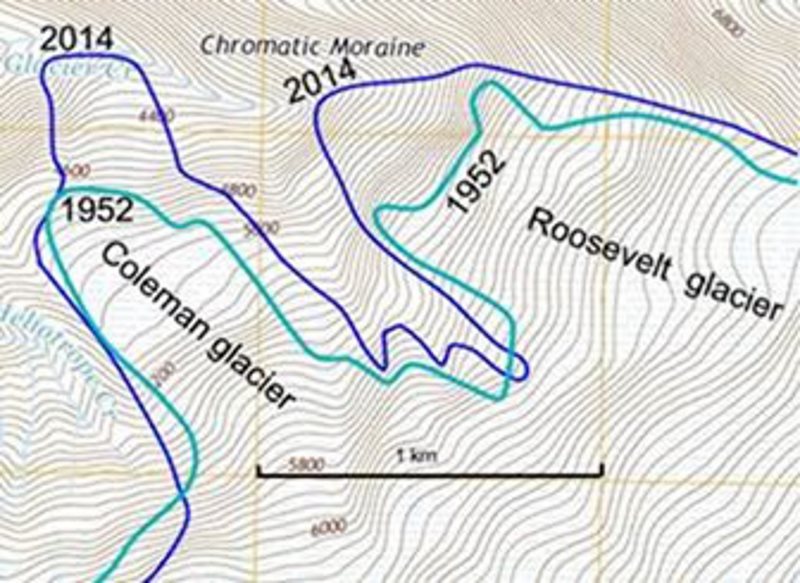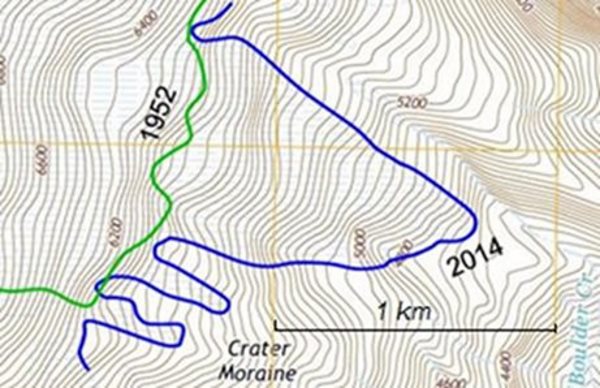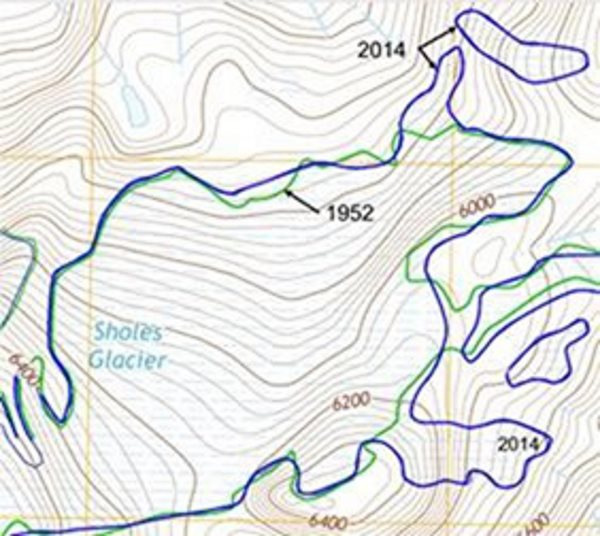'Disastrous': Low snow, heat eat away at Northwest glaciersThis was a multi-page story with numerous photographs and many predictions that glaciers in the North Cascade Mts. will be gone in 50 years. Having just finished a major analysis of Mt. Baker's glaciers dating back thousands of years, I thought, what kind of nonsense is this? So I put together some of the data on Mt. Baker glaciers that will soon be published.
"Glaciers across the North Cascades could lose 5 to 10 percent of their volume this year, accelerating decades of steady decline. One scientist estimates the region's glaciers are smaller than they have been in at least 4,000 years." "The best word for it is disastrous," said Pelto"
Photos and maps from a large collection dating back to 1909 document exactly what Mt. Baker glaciers have done in the past. What these photos and maps clearly show is the Mt. Baker glaciers reached their maximum extent of the past century in 1915 at the end of the 1880 to 1915 cold period. The glaciers then melted back strongly during the 1915 to 1950 warm period. The climate then turned cool again, and Mt. Baker glaciers advanced strongly for 30 years. In 1977, the climate turned warm again and since about 1980, glaciers have been retreating again. However, photos and maps prove that all Mt. Baker glaciers are more extensive today than they were in 1950. Here are a few examples.
Roosevelt and Coleman glaciers
Comparison of the position of the terminus of the Roosevelt glacier on USGS topographic maps of 2014 (blue line) and 1952 (green line) (Fig. 1). Both the Coleman and Roosevelt glaciers are more extensive now than they were in 1952. Figure 2 shows the advance and retreat of the two glaciers measured from vertical air photographs.
Figure 1. Positions of Coleman and Roosevelt termini in 2014 (blue) and 1952 (green) taken directly from USGS topographic maps.
Figure 2. Advance and retreat of the Coleman and Roosevelt glaciers from 1940 to 1990. (Plotted from data in Harper, 1992)
Comparison of photographs of the Roosevelt glacier in 2015 and 1950 confirm that the glacier is more extensive now than in 1950. In the photos below, note that the terminus of the glacier reaches to the edge of dark cliff (left photo) in 2015, but was well upvalley from it in 1950 (right photo). The X on the photos is a point of reference for comparison
.
Figure 3. Comparison of photographs of the Roosevelt glacier in 2015 (left) and 1947 (right). Note that the glacier is more extensive now than it was in 1947.
Deming glacier
Comparison of the position of the terminus of the Deming glacier on USGS topographic maps of 2014 (blue line) and 1952 (green line) (Fig. 4) show that the glacier was more extensive in 2014 than it was in 1952. The right side of the figure shows that rates of advance and retreat of the Deming glacier from 1940 to 1990 (plotted from data in Harper, 1992).
Figure 4. Comparison of the position of the Deming glacier terminus in 2015 and 1952 taken directly from USGS topographic maps (left). Graph on the right shows rates of advance and retreat of the glacier from 1940 to 1990.
Photographs of the Deming glacier 2011-2015 confirm that the glacier is more extensive now than it was in 1950-52. In the photos below the X is a point of reference and the yellow diamond is the terminus. The 2011-2015 terminus is far downvalley (see map) from it's 1950-52 position.
Figure 5. Deming glacier, 1950 (left) and 2011 (right). The yellow X is a point of reference and the diamond shape is the position of the terminus in 1950 and 2011. These photos show that the Deming glacier is more extensive now than it was in 1950 and confirm the positions of the terminus shown in Fig. 4.
Boulder glacier
Comparison of the position of the terminus of the Boulder glacier on USGS topographic maps of 2015 (blue line) and 1952 (green line) (Fig. 6) show that the glacier is more extensive now than it was in 1952.
Figure 6. Comparison of the position of the Boulder glacier terminus in 2014 and 1952 taken directly from USGS topographic maps. The glacier is now more than a kilometer downvalley from its 1952 position.
Figure 7. Photos of the Boulder glacier in 1950 (left) and 2014 (right). The yellow X is a common point of reference and the yellow diamond marks the glacier terminus.
Photographs of the Boulder glacier 2014 confirm that the glacier is more extensive now than it was in 1950-52. The present is far downvalley (see map) from its 1950-52 position.
All of Mt. Baker's other glaciers show the same thing. They are all more extensive now than they were in 1952 and nothing unusual is happening to them—they have been where they are now many times before. Data similar to that shown here for the Coleman, Roosevelt, Deming, and Boulder glaciers is also available for the Easton, Squak, Talum, Park, Rainbow, and Mazama glaciers.
The Seattle Times states that "Riedel estimates the region's glaciers are smaller than they have been in at least 4,000 years." However, the photos and maps of the Sholes glacier, the featured in the Times article, below prove that these claims are totally false ˗˗ the Sholes glacier has not changed at all in the past 70 years.
Figure 8. The Sholes glacier in 1947 (left) and 2011 (right) are virtually identical.
These photos prove that the Sholes glacier today is identical to what it was in 1947. In addition, comparison of the glacier terminus on USGS topographic maps of 1952 and 2014 (below) show that the Sholes glacier has not changed since 1952.
Figure 9. The blue line is the margin of the Sholes glacier shown on the USGS 2014 topographic map. The green line is the terminus position shown on the 1952 map. These maps prove that the Shole glacier today is identical to what it was in 1952.


















Comment: Objective observation, respect for the data are the bedrock of good science. Something the anthropogenic global-warming, 'hockey stick' waving camp has been sadly lacking.
- The Great Modelling Fraud
More good science: